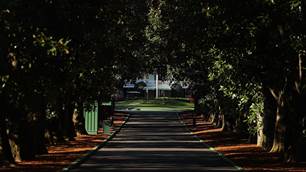With confirmation that Tiger Woods will indeed make a remarkable comeback from injury at the Masters this week, we look back at the pivotal shots he has played en route to winning five green jackets in the past 25 years ... and the lessons to be learned from them.
1997 – INTO RED NUMBERS
 THE SHOT: Tiger Woods’ first Masters as a professional in 1997 was much anticipated … but it didn’t start well. The young phenom was four over through the opening nine holes but all that was forgotten by the time he reached the 10th tee.
THE SHOT: Tiger Woods’ first Masters as a professional in 1997 was much anticipated … but it didn’t start well. The young phenom was four over through the opening nine holes but all that was forgotten by the time he reached the 10th tee.
From there, he birdied the 10th, 12th (with a chip-in) and two-putted for another at the par-5 13th hole to get back to one over.
He attacked the 500-yard par-5 15th with vigour and his drive bounded over the hill, leaving him 151 yards to the flag, which was tucked into the left edge of the huge green. The downhill lie posed no problems for Woods, who flushed a pitching wedge into eight feet and he rolled the putt in for eagle. He moved into red figures for the first time in the tournament and that’s where he stayed en route to reaching 18 under and winning his first Masters by 12 strokes.
WHAT YOU CAN LEARN: Hitting the ball sweetly from a downhill lie isn’t a difficult prospect if your set-up to the ball prepares you correctly to hit the shot.
The first step is to set up to the ball and get your body – primarily your shoulders and hips – aligned to the slope.

On a downhill slope your left shoulder and hip (for right-handers) should be lower than your right. It’s very important to put flex in your lead leg too. Doing this will help keep your weight on the lead leg in your backswing, and your weight forward on the downswing. This allows you to swing down the slope more efficiently.
Position the ball back in your stance more than what you would normally have with a flat lie. When you make your downswing, swing with the slope, keeping the clubhead moving along the slope past impact. This creates a descending strike to the ball. Allow your weight to move forward with your shot and don’t try to lift the ball in the air.
Lastly, the ball will come out lower from a downhill lie. The club you will be using will be de-lofted because of your set-up to the downslope so take this into account when choosing your club (this is why Tiger was able to hit a 151-yard pitching wedge, a 9-iron distance).
 2001 – THE TIGER SLAM
2001 – THE TIGER SLAM
THE SHOT: Tiger Woods arrived in Augusta for the 2001 Masters having won each of the three previous majors – the 2000 US Open, Open and US PGA Championships. A win would see him become the only golfer in history to hold the four major trophies at the same time.
Pushed all the way, he only needed to par the final hole to win his second green jacket and complete the ‘Tiger Slam’. He went one better, rolling in a quick downhiller from
18-feet for birdie to defeat David Duval by two strokes.
WHAT YOU CAN LEARN: There are two lessons to be learned from Woods’ final putt in 2001. Firstly, the key to good putting is to always commit to the stroke before you have even pulled the putter back. If you second guess the line or the speed you will never, ever, make the putt that lies in front of you.
Secondly, always hit your putts with an accelerating stroke, even if they are on a slick, downhill surface. Any kind of deceleration through impact will send the ball off your intended line.
The length of your putt and the speed of the green are obvious influences on the length of your stroke, which should be shorter on the backswing and longer on the follow-through. Achieve this and you know you have accelerated through impact and put a good roll on the ball.

2002 – BACK-TO-BACK
 THE SHOT: Tiger Woods joined Nick Faldo and Jack Nicklaus as the only players with a successful Masters’ title defence when he defeated South African Retief Goosen by three strokes.
THE SHOT: Tiger Woods joined Nick Faldo and Jack Nicklaus as the only players with a successful Masters’ title defence when he defeated South African Retief Goosen by three strokes.
Woods finished at 12 under, which included just seven bogies in the 72 holes and at no stage did he look like he was going to leave the door ajar for any of his opponents.
“You just know Tiger is not going to make any big mistakes,” said Goosen, who played in the final group on Sunday with Woods.
Tiger’s long-time rival Phil Mickelson agreed.
“I think the thing with Tiger is he’s the only leader that you don’t have hope that he’ll falter,” said Mickelson, who began and ended the final round four shots behind Woods.
“When other guys are up there, you know that if you can just stay around there, there’s a good chance they might come back two or three shots. But Tiger doesn’t seem to ever do that.”
WHAT YOU CAN LEARN: Tiger is the master of minimising mistakes. Even when he missed the 5th fairway left in the final round (pictured), he was able to fashion a shot out of trouble that made bogey the worse-case scenario. He took his five, and then grabbed that shot back at the next with a birdie.

Think of golf this way … golf is a game of mistakes and if you can limit the number of mistakes, the lower your score will be.
You’ll never see Tiger hit a shot into the lip of a fairway bunker because he’s been greedy taking too much club to try and reach the green. You’ll rarely, if ever, see Tiger race a
15-foot birdie putt more than three feet past the hole, bringing bogey into play.
These are just some of the simple measures you can take to avoid mistakes and keep your scores down.
2005 – THE CHIP-IN
 THE SHOT: One ahead of Chris DiMarco, Tiger fired his tee shot through the 16th green into a seemingly tough recovery position, with the ball resting just centimetres from the long second cut of rough and a steep slope between it and the quick putting surface and very little green to work with.
THE SHOT: One ahead of Chris DiMarco, Tiger fired his tee shot through the 16th green into a seemingly tough recovery position, with the ball resting just centimetres from the long second cut of rough and a steep slope between it and the quick putting surface and very little green to work with.
Tiger examined the situation then struck his chip firm with spin towards the tier about 25 feet above the hole. The ball checked up perfectly then began to tumble slowly down the slope to the cup. The ball stopped right on the lip before gravity won and the ball dropped for an amazing birdie.
“It was one of the best shots I’ve hit in my career, simply because of the situation … Chris looked like he might make birdie and I looked like making bogey. It was huge,” Woods said.

WHAT YOU CAN LEARN: The two key elements of this incredible shot are loft and speed – enough loft to ensure the ball carried all the way onto the green, and clubhead speed to create the spin that will put the brakes on the ball.
To spin the ball with a lofted wedge, position the ball near the middle of your stance at address. At impact, the club is going to move under the ball to allow spin to be developed on the face, and that is only going to happen with the ball in the middle of your stance.
To help generate the spin required, you need to hit down slightly on the ball, which is why you should lean toward the target at address. For right-handers, that means having about half of your body weight on your left foot.
Lastly, you need clubhead speed through impact to create the spin. In practice, think about brushing the club under the ball along the top of the grass, while accelerating the clubhead through impact.
2019 – TIGER’S BACK
 THE SHOT: Tiger Woods walked onto the 12th tee in the final round, in the midst of a congested leaderboard … all chasing Italy’s Francesco Molinari, the reigning Open Champion. Woods was 11 under having dropped a shot on the 10th to fall two strokes behind.
THE SHOT: Tiger Woods walked onto the 12th tee in the final round, in the midst of a congested leaderboard … all chasing Italy’s Francesco Molinari, the reigning Open Champion. Woods was 11 under having dropped a shot on the 10th to fall two strokes behind.
Molinari was first to hit on the par-3 and his tee shot got knocked down in the slight breeze, hit the bank in front of the green and rolled back into Rae’s Creek. Brooks Koepka, playing in the group in front, did exactly the same moments earlier.
Tiger was next to play and he caressed a 9-iron into the heart of the wide green, some 51 feet away from the cup. It was probably the defining moment of Woods’ historic victory as he two-putted for his par and rose to the top of the leaderboard for the first time in the round.
WHAT YOU CAN LEARN: How many times have you heard a pro say “you need to know where to miss around this golf course.”
And it’s true. Think about your home course. Are there holes where you could save some shots by simply leaving driver in the bag? Or playing for the ‘fat’ part of a green, instead of aiming at the flag.

Having seen Molinari, the leader, dunk his tee shot, Woods purposely aimed away from the flag towards the deepest part of the 12th green. Knowing there were birdies on offer at the 13th and 15th holes, he knew he could capitalise on Molinari’s error by ensuring he didn’t play at ‘the sucker’ right side pin, which would bring the water in play.
You don’t need to be a great ball-striker like Tiger to think your way around a course like him. Play to your strengths and your shot shape. For example, if you’re good with your wedges, make sure to lay-up at an easy wedge distance on par-5s. If you play with a left-to-right fade (for right-handers), play at the centre of a green when the flag is right, and at the flag when it’s on the left.
Related Articles

Playing From The Tips Ep.107: The Masters

Dreaded ravioli on menu for Scheffler's Masters dinner













